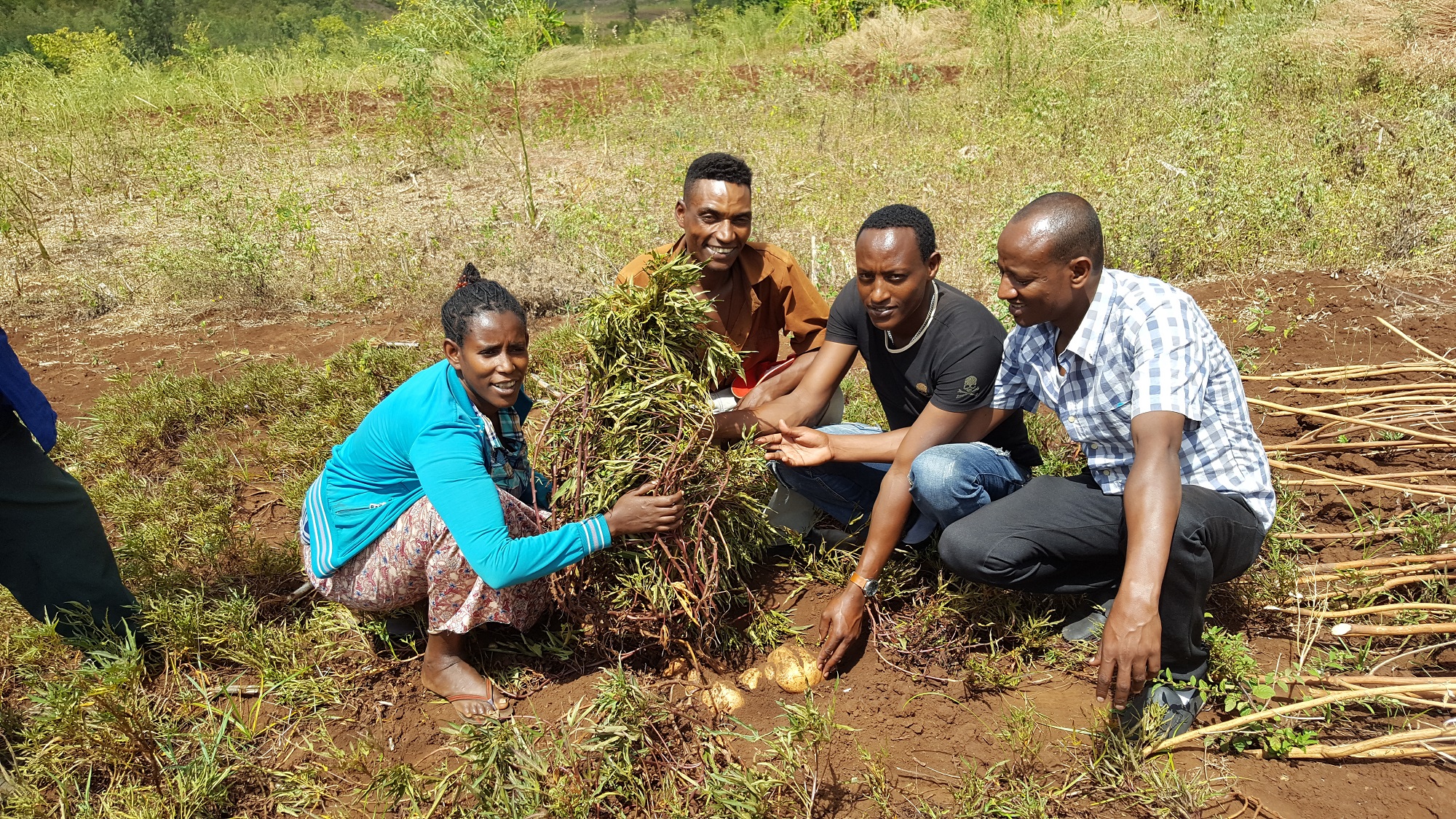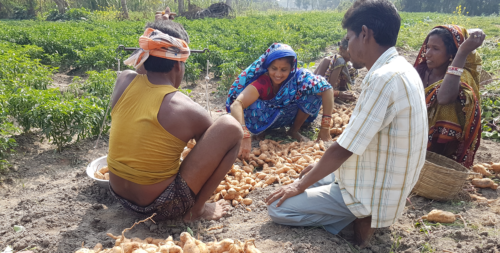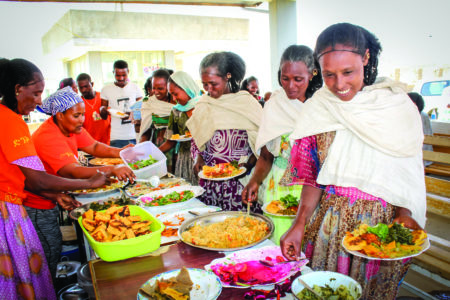
Potato and sweetpotato are ideal food security crops, producing good harvests even under challenging growing conditions. This project directly provided around 20,000 Ethiopian farm households in the Southern Nations, Nationalities and People’s (SNNP) region with quality planting materials and training, enabling them to rebuild their food security following a period of severe drought. Phase II will extend benefits to an additional 20,000 families in need of emergency support in SNNP and Amhara regions.
Background
Ethiopia continues to battle with chronic drought in the aftermath of the 2015 El Nino, which caused widespread crop and livestock losses. The SNNP and Amhara regions were among those worst affected and farmers continue to need emergency support to rebuild their livelihoods.
Although cereal-based diets predominate, potato and sweetpotato are grown widely. They are suitable crops for challenging conditions since they are highly efficient in transforming water into calories, have a short maturity period, and can be harvested during the ‘hunger months’ before the cereals ripen. Orange-fleshed sweetpotato provides a rich source of vitamin A, commonly deficient among Ethiopian children and women of reproductive age.
Working with local partners, particularly the Bureau of Agriculture and Natural Resources Development (BoANRD), the International Potato Center (CIP) implemented an emergency project in 2016 to improve the nutrition and food security of households in SNNP. It has been highly successful in providing planting materials and increasing yields among drought-affected households; however, many more families are struggling to grow sufficient food. Building on the lessons learned, CIP plans to expand its activities to additional farmers in phase II.
Objectives
The goal is to improve the food and nutrition security of at least 41,000 drought-affected farmers (243,000 people). The project provides immediate access to improved seed potato and sweetpotato planting materials, offering productive and well-adapted varieties. It also offers training on production and post-harvest technologies, and raises awareness of nutritional needs.
Approach
The project introduces new, high-yielding varieties of potato and vitamin A-rich orange-fleshed and highly productive and drought-tolerant white-fleshed sweetpotatoes. In addition to distributing planting materials to farmers, the project supplies producer cooperatives high quality seed to renew their stock to ensure producers have access to quality planting material.
Capacity building activities are vital to ensure effective dissemination and build long-term community resilience to drought. Efforts focused on ‘training of trainers’ and ‘model farmers’ approaches, in collaboration with local partners, and covered production technologies, CIP’s ‘Triple S’ (sand, storage, and sprouting) technology to preserve planting material between cultivation seasons and family nutrition.
Potato and sweetpotato are widely grown by women in their backyards, providing valuable food and income for family needs. Interestingly, as potato and sweetpotato cultivation has expanded, women have retained involvement in production and marketing, thus enabling them to play a greater role in family decision-making. Mindsets among farmers are also changing, with male farmers increasingly listening to advice from women who have attended training courses. In line with the Ethiopian government’s development plan to increase gender equality in agriculture, phase II seeks to reach 6,300 women farmers who are household heads.
Phase I achievements
The first phase benefited nearly 20,000 households (about 126,000 people) directly by providing them with planting materials. After the first harvest, the farmers shared their planting material with their neighbors. The farmers welcomed the new potato varieties, reporting that they matured earlier, gave higher yields, improved disease resistance, and had better cooking characteristics than their traditional types. They were particularly impressed with the ‘Gudene’, which both tasted good and on average yielded more than 50 t/ha in high potential districts.
Although slightly skeptical about the new orange-fleshed sweetpotato, smallholder families have embraced it and love its taste. They use it sparingly, mixing it with other traditional foods to ensure adequate intake of vitamin A. In addition to improving food security, the new varieties produce valuable planting materials, which fetch a good price. Farmers now sell seed potatoes and sweetpotato vine cuttings, as well as any surplus harvest, generating valuable cash for medicines, household items, and school fees. Many have also invested in building more sustainable and resilient livelihoods.
Building farmers’ capacity will ensure project achievements are sustained and foster future resilience. Training focused on ‘training of trainers’ and covered production methods, integrated pest management, post-harvest handling and storage, and family nutrition. Trainees shared this knowledge with other farmers, and for the first time BoANRD included similar training modules in its own programs. Efforts to include women in capacity building were particularly successful in the area of food preparation and nutrition, which involved more than 14,000 participants.
Phase II expected outcomes
The second phase targets 21,000 additional droughtaffected farm households in the Amhara and SNNP regions. The same varieties of potato and sweetpotato will be distributed to farmers who have lost their crops and planting materials, are willing to plant potato and sweetpotato, and have sufficient land available. Priority will be given to female-headed households and those with most dependents.
Sustainability will be built in by working with farmer and commercial seed and vine suppliers to ensure quality planting materials continue to be available when CIP support ends. Farmers will receive training in conservation of sweetpotato planting material, rapid multiplication techniques, managing the potato crop for seed, and storage and handling of seed potato. The project aims to increase the proportion of women attending training on crop production and post-harvest technologies to 40%, with a target of over 80% for those attending nutrition training.
Key outcomes
| Outputs | Direct beneficiaries |
|
| 2016–18 | 2018–20 | |
| Model farmers trained on good agronomic practices and field supervision | 195 | At least 150 |
| Farmers received sweetpotato planting materials and training | 13,373 | 12,000 |
| Farmers received seed potato and training | 6,500 | 9,000 |
| Women learned about nutrition and food preparation | 14,262 | At least 10,000 |
| People gained access to improved diets | 117,000 | 126,000 |
Phase I: June 2016-September 2018
Phase II: August 2018-February 2020
Phase I: USD 1.3 million
Phase II: USD 1.5 million
Project Profile: Link to Document
Contact
Berga Lemaga
CIP, Ethiopia
b.lemaga@cgiar.org
Thanks to our donors



